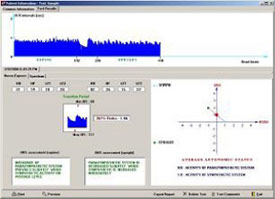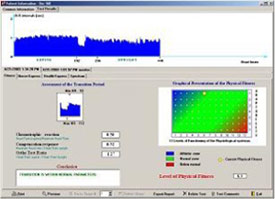Heart Rate Variability Test


Heart Rate Variability
A look at your nervous system function through a “crystal ball.”
What is Heart Rate Variability?
Heart Rate Variability, or “HRV” is the intervals between each heartbeat. When a person is in good health, there is normally a very small but detectable variability of time between each heartbeat. When we stop functioning optimally, this variability narrows and gradually becomes rigid. Heart Rate Variability testing is a proven measure of cardiovascular risk as well as predictor for a myriad of chronic degenerative disorders including hypertension and immune disease. It offers the patient a realistic glimpse of their current health status and an opportunity to pursue a healthy tract into their future.
What is a Heart Rate Variability Test?
The HRV test lasts about 8-9 minutes and is completely painless. A strap is placed around the chest that monitors 448 heartbeats—the first half lying down on your back, and the second half standing. The machine measures the intervals between each heartbeat. Heart Rate Variability is well researched and provides a quick and easy assessment of the Autonomic Nervous System function. The autonomic nervous system is the part of our nervous system that controls the functions that we usually have no conscious control over. We have no conscious control over these functions because they are essential for life and can’t depend on us “remembering” to perform them.
What is the Autonomic Nervous System?
The ANS regulates the basic life-sustaining functions of the body such as the heart beat, heart rate, blood pressure, body temperature, respirations, turning on and off the function of the cells, glands, and organs, maintaining acid/alkaline balance of the blood, saliva, and urine, digestion of food, balancing glandular functions, stimulating and inhibiting the body and its parts.
The Autonomic Nervous System is divided into two parts:
- Sympathetic Nervous System “SNS”
- Parasympathetic Nervous System. “PSNS”
The Sympathetic Nervous System is our “arousal system.” It activates the “fight-or-flight” mechanism when the body detects danger. The sympathetic nervous system is also like the daytime nervous system. It gives us the energy we need to live daily. It also regulates how well our cells get oxygenated and absorb nutrients.
The Parasympathetic Nervous System controls “calming responses” such as sleep, relaxation and digestion. The parasympathetic nervous system works more at night, when the body needs to regenerate our cells and tissues for the next day. Many people’s parasympathetic systems have been weakened, and this is easily seen on the Heart Rate Variability Test.
The Sympathetic Nervous System is like the “gas pedal” in your car. The Parasympathetic Nervous System is like the “brake pedal” in your car.
Both the sympathetic and the parasympathetic nervous systems are important, and they must be in balance at all times. In a healthy person, the SNS and PSNS are in balance. When we are not able to deal with stress in a constructive way, the SNS is often too high, and the PSNS is too low. Since the PSNS controls many systems in the body, then all of those systems are depressed and don’t function optimally.
Remember, we need to have both, just like you need to have a gas pedal and a brake pedal in your car. But if one is not working properly, it can make driving quite a challenge.
Illness, Injury, Stress and your Autonomic Nervous System
The body requires a way to cope with the stress load placed on it every day. Stressors placed on the body in the form of poor diet, fear, danger, general stress, and lack of sleep accumulate and lead to the development of degenerative conditions and premature aging. The parasympathetic nervous system is responsible for keeping the stressors under control or maintaining balance.
When we are dealing with acute and/or chronic illnesses, injuries (whether new or old), and excessive stresses, then our autonomic nervous system is out of balance. In our office, we can assess your autonomic nervous system with this 8-9 minute test that gives us a printout of how your SNS and PSNS are functioning. Then the test can be re-performed over time to see how effective any treatment (supplements, diet, exercise, etc) is working.
With this autonomic nervous system assessment, we can see how much Functional Reserve the patient has. Functional Reserve could be likened to a “savings account” in your body. It’s what your body has in reserve to help in times of need from illness, injury and stress. This guides us in how much therapy can be tolerated at this time. As improvements are made, then additional therapies will be more successful. We can also see the level of functioning of the patient’s general physiology.
What Does The Test Commonly Show?
What we see from this test time and time again are people whose SNS (gas pedal) is too high, meaning too much inability to stay healthy in the face of stress, and whose PSNS (brake pedal) is too low, meaning that the systems of digestion, metabolism, elimination and so forth, are depressed and not functioning as well as needed to promote health. If you have a depressed PSNS it doesn’t matter how hard you diet, or how many supplements you take or how much exercise you do. A depressed PSNS will get in the way of these things working optimally. In addition, a weak PSNS can often be a sign of prolonged emotional stress that may be hidden.
In Conclusion:
Monitoring the autonomic nervous system in fact is an accepted measure of health of the nervous system. It has been found to be extremely helpful in monitoring your health status as you progress through our programs.
The HRV test is used in our office for the monitoring of these systems. Call for your appointment today at 845-354-2100.


